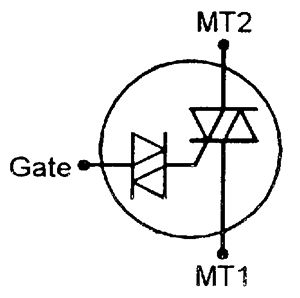What is a Triac?
- A Triac is an electronic component that closely resembles a thyristor but has the ability to conduct current in both directions.
- It has three terminals: Gate, MT1, and MT2.
- The Triac can be triggered into conduction by applying either a positive or negative pulse to the Gate terminal.
How does a Triac Work?
The Triac switches to an OFF state under the following conditions:
- When the voltage across the Triac becomes reverse-biased, meaning the positive voltage becomes negative and vice versa.
- When the power supply is completely removed.
- By shorting the two terminals of the Triac using a small resistor or a switch.
- It also turns OFF if a weak current flows through it, known as the minimum holding current (Ih).
Triac Symbol

Triac Symbol
Triac Problem: Gate Signal Variations
The Problem:
One of the drawbacks of the Triac is that the gate signal magnitude differs depending on whether it is positive or negative. In other words, the turn-on voltage for the positive half-wave may differ from that of the negative half-wave in most cases.
For instance, it may require 4 volts positive to trigger the Triac in one half-wave and 7 volts positive in the other half-wave.
First Solution:
To address this issue, a diac is often placed at the Triac's gate. The diac ensures that the Triac's gate receives a voltage signal only when the diac is already conducting and possesses symmetrical values for both positive and negative triggering. This ensures more consistent and reliable triggering of the Triac, regardless of the half-wave polarity.
Second Solution (Quadrac):

Quadrac Symbol
Quadrac: An electronic component that combines Triac and Diac characteristics, allowing bidirectional current conduction with precise and symmetrical triggering for efficient AC power control.